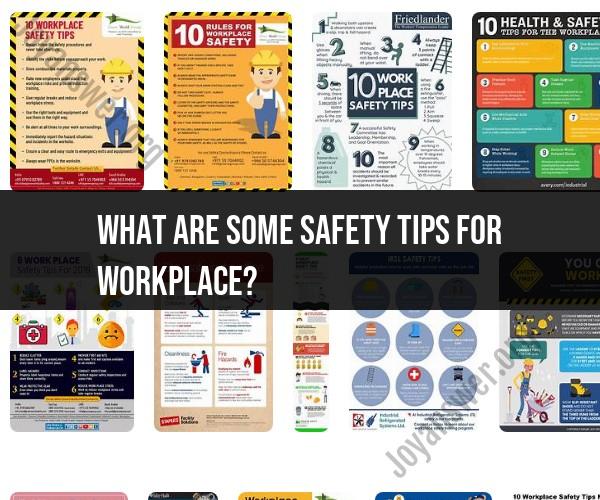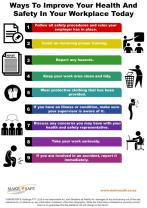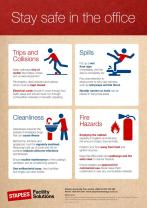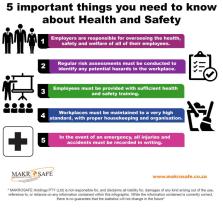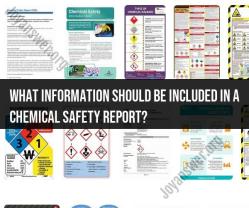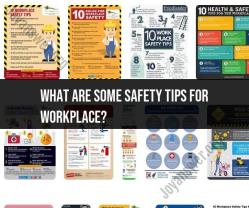What are some safety tips for workplace?
Workplace safety is crucial to protect yourself and others from accidents and injuries. Here are some general workplace safety tips to help ensure a safe working environment:
Know the Hazards: Understand the potential hazards in your workplace. This includes physical hazards (e.g., machinery), chemical hazards (e.g., chemicals and substances), biological hazards (e.g., viruses or bacteria), and ergonomic hazards (e.g., poor workstation setup).
Follow Safety Procedures: Always follow safety procedures and protocols established by your employer. These may include operating equipment safely, handling hazardous materials properly, and using personal protective equipment (PPE) when required.
Use Personal Protective Equipment (PPE): Wear appropriate PPE, such as helmets, gloves, safety glasses, masks, earplugs, or respirators, as necessary for your job. Make sure your PPE fits properly and is in good condition.
Proper Lifting Techniques: If your job involves lifting, learn and use proper lifting techniques to prevent strains and injuries. Bend your knees, not your back, and lift with your legs.
Ergonomic Workstations: Ensure your workstation is ergonomically designed to reduce the risk of musculoskeletal disorders. Adjust your chair, monitor, and keyboard to promote good posture and reduce strain.
Fire Safety: Familiarize yourself with fire exits, fire extinguishers, and evacuation procedures. Participate in fire drills and know how to use a fire extinguisher if required.
Emergency Response: Know the location of first aid kits and how to administer basic first aid. Be aware of emergency contact numbers and procedures in case of accidents or medical emergencies.
Report Hazards: If you identify a hazard or potential danger in the workplace, report it to your supervisor or safety officer immediately. Do not ignore or attempt to fix unsafe conditions yourself.
Safety Training: Participate in workplace safety training sessions and refreshers. Stay informed about the latest safety guidelines and best practices.
Stay Alert: Avoid distractions and stay focused on your tasks while working. Being alert to your surroundings can help prevent accidents.
Avoid Shortcuts: Do not take shortcuts when it comes to safety. Always follow established procedures, even if it seems more convenient to skip certain steps.
Proper Tool and Equipment Use: Use tools and equipment only for their intended purposes. Ensure equipment is well-maintained and in good working condition.
Safe Chemical Handling: If you work with chemicals, follow proper storage, handling, and disposal procedures. Be aware of the potential hazards associated with the chemicals you use.
Rest and Breaks: Take regular breaks to rest and recharge, especially if your job involves repetitive tasks. Fatigue can lead to accidents.
Communication: Maintain open communication with coworkers about safety concerns. Encourage a culture of safety where everyone looks out for one another.
Safety Committee: If your workplace has a safety committee, consider getting involved. Your input can help improve safety measures.
Stay Informed: Stay up-to-date on industry-specific safety standards and regulations that apply to your job.
Remember that workplace safety is a shared responsibility, and everyone in the workplace should contribute to creating a safe and healthy environment. By following these safety tips and being proactive about safety, you can help prevent accidents and injuries at work.
Workplace Safety: Essential Tips for a Safer Work Environment
- Be aware of your surroundings and potential hazards. This includes being mindful of other people, moving objects, and tripping hazards.
- Follow safety procedures and guidelines. These procedures are in place for a reason, and following them can help prevent accidents and injuries.
- Use the proper tools and equipment for the job. Make sure you know how to use them safely before operating them.
- Wear personal protective equipment (PPE) when necessary. PPE can include hard hats, safety glasses, gloves, and respirators.
- Report any unsafe conditions or hazards to your supervisor. It is important to address potential problems before they cause an accident.
Keeping Your Workplace Secure: Safety Guidelines and Best Practices
- Implement physical security measures. This may include locks, security cameras, and alarms.
- Control access to your workplace. Use key cards or security passes to restrict access to authorized personnel.
- Educate employees on security procedures. Make sure employees know how to report suspicious activity and how to keep their workstations and workspaces secure.
- Conduct regular security audits. This will help you identify any security vulnerabilities and make necessary improvements.
A Secure Workspace: Top Safety Tips for Employees and Employers
For employees:
- Be aware of your surroundings and report any suspicious activity to your supervisor.
- Keep your workstation and workspace clean and organized. This will help you identify potential hazards and make it more difficult for unauthorized individuals to access your work materials.
- Use strong passwords and keep them confidential. Avoid using easily guessed passwords, such as your name or birthday.
- Be careful about what information you share online. Avoid sharing personal information, such as your home address or phone number, on social media or other public websites.
For employers:
- Provide employees with security training. This training should cover topics such as how to report suspicious activity, how to keep workstations and workspaces secure, and how to use passwords safely.
- Implement security policies and procedures. These policies and procedures should cover all aspects of security, from physical security to cybersecurity.
- Monitor security cameras and alarms regularly. This will help you identify and respond to security incidents quickly.
- Keep software and security systems up to date. This will help to protect your workplace from the latest security threats.
By following these tips, you can help to create a safer and more secure workplace for everyone.
